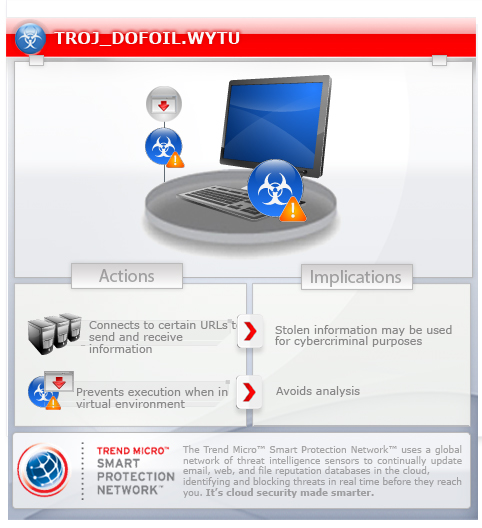TROJ_DOFOIL.WYTU
Trojan.Win32.Sharik.ugy (Kaspersky)
Windows


Threat Type: Trojan
Destructiveness: No
Encrypted: Yes
In the wild: Yes
OVERVIEW
This Trojan comes from a malware family that employs evasion tactics such as checking if it is running in a virtual environment. This malware is linked to the FlashPack exploit kit.
To get a one-glance comprehensive view of the behavior of this Trojan, refer to the Threat Diagram shown below.

This Trojan arrives on a system as a file dropped by other malware or as a file downloaded unknowingly by users when visiting malicious sites.
It connects to certain websites to send and receive information. However, as of this writing, the said sites are inaccessible.
TECHNICAL DETAILS
Arrival Details
This Trojan arrives on a system as a file dropped by other malware or as a file downloaded unknowingly by users when visiting malicious sites.
This malware arrives via the following means:
- flash pack exploit kit
Installation
This Trojan drops the following copies of itself into the affected system:
- %Application Data%\{random1}{random2}.exe
where {random1} and {random2} are generated from hashed computername
(Note: %Application Data% is the Application Data folder, where it usually is C:\Documents and Settings\{user name}\Application Data on Windows 2000, Windows Server 2003, and Windows XP (32- and 64-bit); C:\Users\{user name}\AppData\Roaming on Windows Vista (32- and 64-bit), Windows 7 (32- and 64-bit), Windows 8 (32- and 64-bit), Windows 8.1 (32- and 64-bit), Windows Server 2008, and Windows Server 2012.)
It adds the following mutexes to ensure that only one of its copies runs at any one time:
- hashed computer name and volume serial number
Autostart Technique
This Trojan drops the following file(s) in the Windows User Startup folder to enable its automatic execution at every system startup:
- %User Startup%\{random1}.lnk
where {random1} is generated from hashed computername
(Note: %User Startup% is the current user's Startup folder, which is usually C:\Windows\Profiles\{user name}\Start Menu\Programs\Startup on Windows 98 and ME, C:\WINNT\Profiles\{user name}\Start Menu\Programs\Startup on Windows NT, and C:\Documents and Settings\{User name}\Start Menu\Programs\Startup.)
Other Details
This Trojan connects to the following website to send and receive information:
- http://{BLOCKED}nkad.com/bimforum
- http://{BLOCKED}hkinho.org/bimforum
It does the following:
- It sends the following HTTP request to report status of infection:
- &cmd={getload or grab or getproxy}
- &login={computer name hashed}{volume serial number}
- &bits={value}
- &file={value}
- &run=ok
- &sel={malware version name}
- &ver={malware version}
where malware version name is ffbot and malware version number is 5.1 - It does not perform its intended routine if the following applications are seen:
- sbiedll
- dbghelp
- qemu
- virtual
- VMware
- xen
- It waits to receive an arbitrary file from the server
However, as of this writing, the said sites are inaccessible.
SOLUTION
Step 1
Before doing any scans, Windows XP, Windows Vista, and Windows 7 users must disable System Restore to allow full scanning of their computers.
Step 2
Scan your computer with your Trend Micro product and note files detected as TROJ_DOFOIL.WYTU
Step 3
Restart in Safe Mode
Step 4
Search and delete these files
- %User Startup%\{random1}.lnk
Step 5
Restart in normal mode and scan your computer with your Trend Micro product for files detected as TROJ_DOFOIL.WYTU. If the detected files have already been cleaned, deleted, or quarantined by your Trend Micro product, no further step is required. You may opt to simply delete the quarantined files. Please check this Knowledge Base page for more information.
Did this description help? Tell us how we did.


